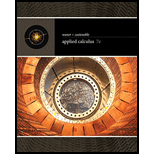
Concept explainers
Let f have the graph shown.
![Chapter 3.5, Problem 35E, Let f have the graph shown. a. The average rate of change of f over [2,4] is (A) greater than f(2).](https://content.bartleby.com/tbms-images/9781337291248/Chapter-3/images/91248-3.5-35e-question-digital_image121.png)
a. The average rate of change of f over
is
(A) greater than
(B) less than
(C) approximately equal to
b. The average rate of change of f over
is
(A) greater than
(B) less than
(C) approximately equal to
c. Over the interval
(A) increasing.
(B) decreasing.
(C) neither.
d. Over the interval
(A) increasing, then decreasing.
(B) decreasing, then increasing.
(C) always increasing.
(D) always decreasing.
e. when
is
(A) approximately 0 and increasing at a rate of about 0.7 units per unit of x.
(B) approximately 0 and decreasing at a rate of about 0.7 units per unit of x.
(C) approximately 0.7 and increasing at a rate of about 1 units per unit of x.
(D) approximately 0.7 and decreasing at a rate of about 3 units per unit of x.
Want to see the full answer?
Check out a sample textbook solution
Chapter 3 Solutions
Applied Calculus
Additional Math Textbook Solutions
Algebra and Trigonometry (6th Edition)
Elementary Algebra For College Students (10th Edition)
Beginning and Intermediate Algebra
Calculus: Early Transcendentals (2nd Edition)
Thinking Mathematically (6th Edition)
Elementary Statistics ( 3rd International Edition ) Isbn:9781260092561
- I need help in ensuring that I explain it propleryy in the simplifest way as possiblearrow_forwardI need help making sure that I explain this part accutartly.arrow_forwardPlease help me with this question as I want to know how can I perform the partial fraction decompostion on this alebgric equation to find the time-domain of y(t)arrow_forward
- Please help me with this question as I want to know how can I perform the partial fraction on this alebgric equation to find the time-domain of y(t)arrow_forwardEvaluate F³ - dr where ♬ = (4z, -4y, x), and C' is given by (t) = (sin(t), t, cos(t)), 0≤t≤ñ .arrow_forwardMid-Term Review Find the formula for (f + g)(x). f(x) = x² - 10x + 25 and g(x) = x² - 10x + 24 (f + g) (x) = [ 2 ]x² X + DELL Skip Sarrow_forward
- Calculus III May I please have some elaborations on Example 2 part a? Thank you.arrow_forward1. A bicyclist is riding their bike along the Chicago Lakefront Trail. The velocity (in feet per second) of the bicyclist is recorded below. Use (a) Simpson's Rule, and (b) the Trapezoidal Rule to estimate the total distance the bicyclist traveled during the 8-second period. t 0 2 4 6 8 V 10 15 12 10 16 2. Find the midpoint rule approximation for (a) n = 4 +5 x²dx using n subintervals. 1° 2 (b) n = 8 36 32 28 36 32 28 24 24 20 20 16 16 12 8- 4 1 2 3 4 5 6 12 8 4 1 2 3 4 5 6arrow_forward= 5 37 A 4 8 0.5 06 9arrow_forward
 Algebra and Trigonometry (MindTap Course List)AlgebraISBN:9781305071742Author:James Stewart, Lothar Redlin, Saleem WatsonPublisher:Cengage Learning
Algebra and Trigonometry (MindTap Course List)AlgebraISBN:9781305071742Author:James Stewart, Lothar Redlin, Saleem WatsonPublisher:Cengage Learning College AlgebraAlgebraISBN:9781305115545Author:James Stewart, Lothar Redlin, Saleem WatsonPublisher:Cengage Learning
College AlgebraAlgebraISBN:9781305115545Author:James Stewart, Lothar Redlin, Saleem WatsonPublisher:Cengage Learning
 Trigonometry (MindTap Course List)TrigonometryISBN:9781337278461Author:Ron LarsonPublisher:Cengage Learning
Trigonometry (MindTap Course List)TrigonometryISBN:9781337278461Author:Ron LarsonPublisher:Cengage Learning Algebra & Trigonometry with Analytic GeometryAlgebraISBN:9781133382119Author:SwokowskiPublisher:Cengage
Algebra & Trigonometry with Analytic GeometryAlgebraISBN:9781133382119Author:SwokowskiPublisher:Cengage





